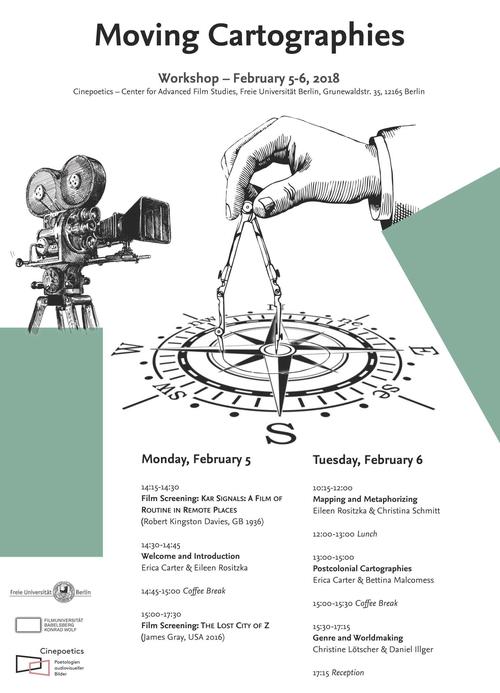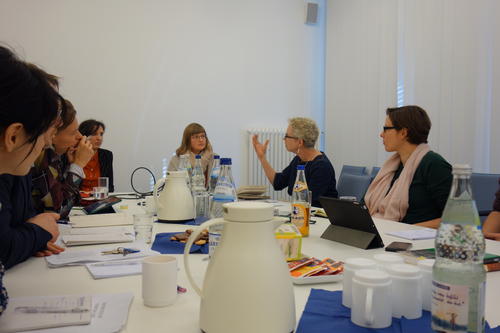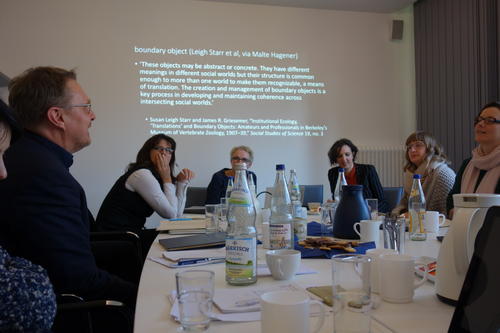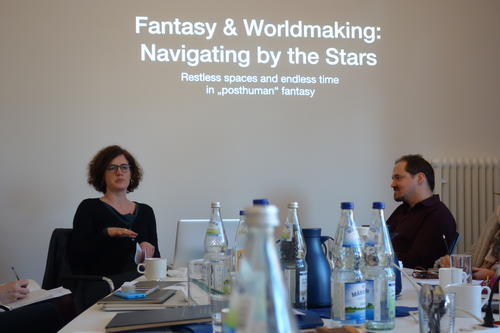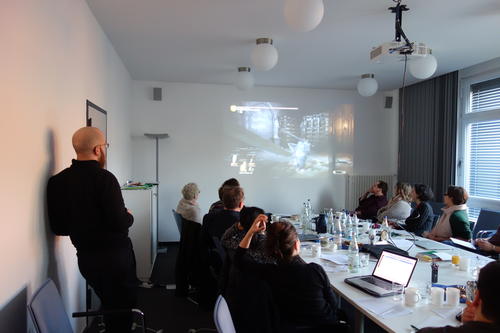Moving Cartographies
05./06.02.2018 | Workshop der Kolleg-Forschungsgruppe mit Erica Carter und Eileen Rositzka.
As the term "mapping" has become a comfortably broad term in academic discourse on space, cognition, or socio-political relations, the workshop aimed at taking a closer look on the decidedly poetic practice this term comprises. "Moving Cartographies," as Erica Carter and Eileen Rositzka outlined in their introduction, "understands mapping as a cartographic operation, a way of coming to terms with a given space, a way of exercising political power." As such, it is to be found in different phenomena, reaching from colonial archival footage to contemporary Hollywood blockbusters, from the literary 'New Weird' to subjective ventures into the world of video games.
Following the screening of THE LOST CITY OF Z (USA, 2016) on the first day, Eileen Rositzka and Christina Schmitt (both post-doctoral researchers at Cinepoetics) gave an insightful presentation on "Mapping and Metaphorizing" in the film by James Gray. The notion of embodied meaning-making by the viewer is located both in navigating through the film as well as in metaphorizing. Cinematic metaphor is then the product of these dynamic interactions between changing realms or projections. Gray's film underlines the importance of mapping in every part of cinematic staging: on the one hand, this includes framing as a process of an explorative gaze, while on the other, this gaze also needs to break with determined (b)orders.
Reaching out to philosophical positions on spatiality, Rositzka and Schmitt constructed a dynamic relation between places that reach into each other (de Certeau) and rhizomatic maps as practices that always include deterritorialization (Deleuze/Guattari). THE LOST CITY OF Z complicates these further as it creates surface-effects in sound, in its use of photographs, and its vegetational framing in the composition of jungle images.
In her talk "Interior and Exterior Territories: Moving Images in the War Journal as Modes of Inscription", Bettina Malcomess (King's College London) shed light on British colonial films and photography from a decidedly subjective perspective. She described the "competing textualities" of archival material from colonial South Africa (including 16mm-films, photographic accounts, and journal entries of high-ranking British officers) that demand scholarly practices of mapping by tracing its discourse.
However, it is not only the material itself that creates a distinct outlook on mapping, as became clear in the screening of KAR SIGNALS: A FILM OF ROUTINE IN REMOTE PLACES (GB, 1936) by Robert Kingston Davies. As the viewer follows the "making" of a map for military use through heliographic posts, they are permanently reminded of the volatility inherent in cinematic mapping. We follow the infrastructure of the Anglo-Boer War, travelling from post to post, and movement of light through filmic space, while enjoying the establishing and failing "technocratic organization of space."
Also taking a post-colonial perspective on film, Erica Carter (King's College London, senior fellow at Cinepoetics) ventured into different realms in her talk "Film Experience as Embodied Mapping – Expats on Tour in the Empire." Relating to Paul Gilroy's concept of the 'Black Atlantic,' which describes slave ships crossing the Atlantic as a chronotope of a micropolitical system in motion, Carter analyzed socio-cultural as well as historical implications of film in building a white British colonial identity. A so-called 'White Atlantic' would consider film relations between Hollywood films, British productions, and newsreels in the context of perpetual migration between the colonies – including film projections during ship travel.
Thus, Carter outlined a 'histoire croisée' (Zimmermann/Werner) that consists of dislocation and mobility, class anxiety, racialized imagery of nation, and imperial nostalgia in post-war Britain. Films become spatializing practices in the sense of Michel de Certeau: they function as 'white entertainment' that unfolds in these dynamic relations of migration and the crisis of racial and national identity.
In their shared presentation, Christine Lötscher and Daniel Illger (both senior fellows at Cinepoetics) analyzed the spatial techniques of world making in the fantasy genre. "Navigating by the Stars – Restless Spaces and Endless Time in 'Posthuman' Fantasy" focused on the 'fallen world' that is often the foundation spatiality in this genre. As this notion of the 'fallen world' stems from a crisis of humanity, these spaces are not fixed but shifting landscapes in time. The poetic act of world making is rather to be understood as an act of 'assemblage,' following Deleuze/Guattari.
Lötscher strikingly illustrated this concept in her analysis of Jeff VanderMeer's 2017 novel "Borne." As this text builds on post-human notions of world making, it cannot free itself from finding a decidedly human perspective in its language. This tension leads to the inherent genre poetics of 'New Weird' literature. Yet again, analyses must rely on the plurality of space, and on space as practice. In a similar way, Daniel Illger presented "a cursed world that has to be redeemed" in the video game "Dark Souls 3." Its complex level design that equally focuses on the vertical as well as the horizontal axis can never be fully understood by the player. Illger described the gaming experience as "blissful frustration," considering both the difficulty and lack of orientation for the player. Thus, it alludes to Ruskin's theory of the gothic in the longing for evermore stories, which is at the same time melancholic and depressing.
